I am new to using R and learning how to create forest plots using the forestplot function.
I am struggling with labeling y-axis of the forest plot using:
labeltext = matrix()
When I use this:
labeltext = matrix(c(data$BCT, data$present), nrows=40, ncol=2, byrow=TRUE, dimnames=NULL)
I get a numeric matrix and R ignores the text in the scv file I provide.
It seems to work when I make a matrix for one column. How do I label y-axis using two columns from a csv file?
I want to achieve something like this:
but instead of 'reference', 'lact', and 'diet' it should say 'BCT' and 'present'.
I want a forest plot that has 'BCT' (column 1) and 'present' (column 2) as the y-axis labels. SMD is the effect measure, and upper_limit and lower_limit are CI. See sample data below
Here is the code:
library(forestplot)
labeltext = matrix(c(data$BCT, data$present), nrow = 40, ncol = 2, byrow = TRUE, dimnames = NULL)
is_summary = FALSE
forestplot(labeltext,
graph.pos = 2,
mean = data$SMD,
lower = data$"lower_limit",
upper = data$"upper_limit",
is.summary = is_summary,
xlab = "<-------Comparator Better---------------Main Intervention Better-------->",
line.margin = unit (0.8, "cm"),
lineheight = unit (0.5, "cm"),
hrlz.lines =TRUE,
col = fpColors(box = "darkred", lines = "grey", summary = "black"),
graphwidth = unit (10, "cm"))
# Sample Input Data
data <- structure(list(
BCT = c("Adding objects to the environment (12.5) ", "Adding objects to the environment (12.5) ", "Action planning (1.4)", "Action planning (1.4)", "Body changes (12.6) ", "Body changes (12.6) ", "Behavioural practice/rehearsal (8.1)", "Behavioural practice/rehearsal (8.1)", "Credible source (9.2)", "Credible source (9.2)", "Demonstration of the behaviour (6.1) ", "Demonstration of the behaviour (6.1) ", "Feedback on behaviour (2.2) ", "Feedback on behaviour (2.2) ", "Goal setting (behaviour) (1.1)", "Goal setting (behaviour) (1.1)", "Graded tasks (8.7)", "Graded tasks (8.7)", "Generalisation of target behaviour (8.6) ", "Generalisation of target behaviour (8.6) ", "Information about health consequences (5.1)", "Information about health consequences (5.1)", "Instruction on how to perform the behaviour (4.1)", "Instruction on how to perform the behaviour (4.1)", "Monitoring of behaviour by others without feedback (2.1)", "Monitoring of behaviour by others without feedback (2.1)", "Monitoring of outcomes of behaviour without feedback (2.5)",
"Monitoring of outcomes of behaviour without feedback (2.5)", "Problem solving (1.2) ", "Problem solving (1.2) ", "Social Comparison (6.2)", "Social Comparison (6.2)", "Self-monitoring of behaviour (2.3) ", "Self-monitoring of behaviour (2.3) ", "Self-monitoring of outcome(s) of behaviour (2.4) ", "Self-monitoring of outcome(s) of behaviour (2.4) ", "Social support (emotional) (3.3)", "Social support (emotional) (3.3)", "Social support (unspecified) (3.1) ", "Social support (unspecified) (3.1) "),
present = c("present ", "not present", "present ", "not present", "present ", "not present", "present ", "not present", "present ", "not present", "present", "not present", "present ", "not present", "present ", "not present", "present ", "not present", "present ", "not present", "present ", "not present", "present ", "not present", "present ", "not present", "present ", "not present", "present ", "not present", "present ", "not present", "present ", "not present", "present ", "not present", "present ", "not present", "present ", "not present"),
SMD = c(1.69, 0.42, 0.78, 0.4, 0.36, 0.57, 0.71, 0.4, 2.23, 0.31, 0.32, 0.63, 0.45, 0.58, 0.79, 0.26, 0.55, 0.56, 1.39, 0.4, 0.6, 0.46, 0.7, 0.34, 2.53, 0.47, 0.36, 0.62, 0.2, 0.7, 0.03, 0.66, 0.68, 0.47, 1.14, 0.4, 1.13, 0.44, 0.67, 0.52),
lower_limit = c(-1.49, 0.22, -0.4, 0.06, 0.08, -0.33, -0.34, -0.04, 0.15, 0.2, 0.14, -0.4, -0.25, -0.26, -0.19, 0.11, -0.66, 0.23, -0.68, 0.19, -0.35, 0.11, -0.46, 0.15, 1.36, 0.05, -0.07, -0.2, -0.01, -0.18, -0.42, -0.14, -0.4, 0.06, -0.84, 0.16, -1.47, 0.24, -0.93, 0.27),
upper_limit = c(4.87, 0.62, 1.95, 0.74, 0.65, 1.48, 1.75, 0.84, 4.32, 0.42, 0.51, 1.67, 1.15, 1.43, 1.77, 0.41, 1.77, 0.89, 3.46, 0.6, 1.55, 0.81, 1.87, 0.53, 3.7, 0.89, 0.78, 1.43, 0.41, 1.58, 0.47, 1.46, 1.77, 0.88, 3.12, 0.64, 3.72, 0.65, 2.28, 0.78)),
.Names = c("BCT", "present", "SMD", "lower_limit", "upper_limit"),
row.names = c(NA, -40L), class = "data.frame")
